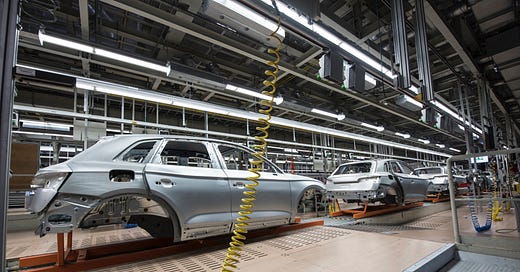The Toyota Production System: The Industry Gold Standard and Its Future Adaptations
Tracing the Evolution of Lean Manufacturing and Its Future Potential
Over the years, one name has emerged as a synonym for superior manufacturing - Toyota. The Toyota Production System (TPS), often referred to as 'Lean Manufacturing,' has significantly influenced the global manufacturing sector, setting a high bar for efficiency, quality, and continuous improvement1. As we delve into the Industry 4.0 era, let's explore how TPS has become the industry standard and how it's adapting to the future.
The Toyota Production System: A Pillar of Excellence
The TPS emerged out of post-World War II Japan, where resources were scarce, and efficiency was crucial. Taiichi Ohno, an industrial engineer at Toyota, developed this system, which emphasizes eliminating waste (muda), inconsistency (mura), and overburden (muri)2.
It is this relentless pursuit of waste reduction and continuous improvement, known as Kaizen, that made TPS a benchmark in the manufacturing sector. It has enabled Toyota to maintain high quality, reduce costs, and respond effectively to customer demands.
How TPS Became the Industry Standard
The adoption of TPS as an industry standard is largely due to its remarkable success. It fundamentally shifted the manufacturing landscape by challenging traditional mass production systems. By prioritizing flow (or smoothness of work), Toyota successfully shortened lead times, minimized stocked inventory, and improved overall efficiency.
Moreover, TPS transcends the mere mechanics of manufacturing, focusing equally on the human element. Respect for people, one of the two main pillars of TPS, fosters a culture of continuous improvement and encourages employee engagement3.
TPS in the Age of Industry 4.0
As we transition into the digital era of Industry 4.0, the principles of TPS remain relevant, but their application is evolving. This new age, characterized by smart factories, the Internet of Things (IoT), and artificial intelligence, presents an opportunity for TPS to integrate with these technologies.
For example, real-time data generated by IoT devices can provide unprecedented insights into waste and inefficiencies, further enabling the lean principles of TPS. Predictive analytics and machine learning can identify patterns and predict future outcomes, which supports proactive decision-making and preempts problems4.
Moreover, advanced robotics and automation can take over repetitive tasks, improving productivity and reducing muri (overburden). Thus, the combination of TPS principles with Industry 4.0 technologies can create a leaner, more efficient, and more human-centric manufacturing sector.
Looking Ahead: TPS and the Future of Manufacturing
TPS has stood the test of time, evolving with the manufacturing landscape while remaining rooted in its core principles. As Industry 4.0 reshapes manufacturing, the integration of TPS with new technologies holds immense potential.
In the future, we can expect a manufacturing sector that is more efficient, adaptable, and human-centered, keeping TPS at its core while embracing the power of digital transformation. As Toyota's journey has shown us, continuous improvement isn't just a principle—it's a path to manufacturing excellence.
Stay tuned as we continue to unlock actionable insights into the fascinating world of manufacturing and technology.
Until next time, stay efficient, stay lean, and keep innovating!
Footnotes
Liker, J.K. (2004). The Toyota Way: 14 Management Principles from the World's Greatest Manufacturer. McGraw-Hill. ↩
Ohno, T. (1988). Toyota Production System: Beyond Large-Scale Production. Productivity Press. ↩
Toyota. (2021). The Toyota Way. Retrieved from https://global.toyota/en/company/vision-and-philosophy/production-system/ ↩
Lu, Y. (2017). Industry 4.0: A survey on technologies, applications and open research issues. Journal of Industrial Information Integration, 6, 1-10. ↩





